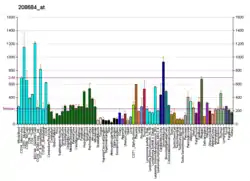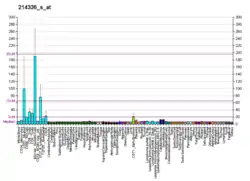| COPA | |||||||||||||||||||||||||||||||||||||||||||||||||||
|---|---|---|---|---|---|---|---|---|---|---|---|---|---|---|---|---|---|---|---|---|---|---|---|---|---|---|---|---|---|---|---|---|---|---|---|---|---|---|---|---|---|---|---|---|---|---|---|---|---|---|---|
| |||||||||||||||||||||||||||||||||||||||||||||||||||
| Identifiers | |||||||||||||||||||||||||||||||||||||||||||||||||||
| Aliases | COPA, HEP-COP, AILJK, coatomer protein complex subunit alpha, alpha-COP, COPI coat complex subunit alpha | ||||||||||||||||||||||||||||||||||||||||||||||||||
| External IDs | OMIM: 601924 MGI: 1334462 HomoloGene: 3218 GeneCards: COPA | ||||||||||||||||||||||||||||||||||||||||||||||||||
| |||||||||||||||||||||||||||||||||||||||||||||||||||
| |||||||||||||||||||||||||||||||||||||||||||||||||||
| |||||||||||||||||||||||||||||||||||||||||||||||||||
| Wikidata | |||||||||||||||||||||||||||||||||||||||||||||||||||
| |||||||||||||||||||||||||||||||||||||||||||||||||||
Coatomer subunit alpha is a protein that in humans is encoded by the COPA gene.[4][5]
Function
In eukaryotic cells, protein transport between the endoplasmic reticulum and Golgi compartments is mediated in part by non-clathrin-coated vesicular coat proteins (COPs). Seven coat proteins have been identified, and they represent subunits of a complex known as coatomer. The subunits are designated alpha-COP, beta-COP, beta-prime-COP, gamma-COP, delta-COP, epsilon-COP, and zeta-COP. The alpha-COP, encoded by COPA, shares high sequence similarity with RET1, the homologous alpha subunit of the coatomer complex in yeast.[6] Also, the N-terminal 25 amino acids of alpha-COP encode the bioactive peptide, xenin, which stimulates exocrine pancreatic secretion and may act as a gastrointestinal hormone. Alternative splicing results in multiple splice forms encoding distinct isoforms.[5]
Interactions
COPA (gene) has been shown to interact with COPE[7][8][9] and COPB1.[10]
References
- 1 2 3 GRCm38: Ensembl release 89: ENSMUSG00000026553 - Ensembl, May 2017
- ↑ "Human PubMed Reference:". National Center for Biotechnology Information, U.S. National Library of Medicine.
- ↑ "Mouse PubMed Reference:". National Center for Biotechnology Information, U.S. National Library of Medicine.
- ↑ Chow VT, Quek HH (July 1996). "HEP-COP, a novel human gene whose product is highly homologous to the alpha-subunit of the yeast coatomer protein complex". Gene. 169 (2): 223–7. doi:10.1016/0378-1119(95)00738-5. PMID 8647451.
- 1 2 "Entrez Gene: COPA coatomer protein complex, subunit alpha".
- ↑ Gerich B, Orci L, Tschochner H, Lottspeich F, Ravazzola M, Amherdt M, Wieland F, Harter C (April 1995). "Non-clathrin-coat protein alpha is a conserved subunit of coatomer and in Saccharomyces cerevisiae is essential for growth". Proc. Natl. Acad. Sci. U.S.A. 92 (8): 3229–33. Bibcode:1995PNAS...92.3229G. doi:10.1073/pnas.92.8.3229. PMC 42139. PMID 7724544.
- ↑ Stelzl U, Worm U, Lalowski M, Haenig C, Brembeck FH, Goehler H, Stroedicke M, Zenkner M, Schoenherr A, Koeppen S, Timm J, Mintzlaff S, Abraham C, Bock N, Kietzmann S, Goedde A, Toksöz E, Droege A, Krobitsch S, Korn B, Birchmeier W, Lehrach H, Wanker EE (September 2005). "A human protein-protein interaction network: a resource for annotating the proteome". Cell. 122 (6): 957–68. doi:10.1016/j.cell.2005.08.029. hdl:11858/00-001M-0000-0010-8592-0. PMID 16169070. S2CID 8235923.
- ↑ Eugster A, Frigerio G, Dale M, Duden R (August 2000). "COP I domains required for coatomer integrity, and novel interactions with ARF and ARF-GAP". EMBO J. 19 (15): 3905–17. doi:10.1093/emboj/19.15.3905. PMC 306616. PMID 10921873.
- ↑ Faulstich D, Auerbach S, Orci L, Ravazzola M, Wegchingel S, Lottspeich F, Stenbeck G, Harter C, Wieland FT, Tschochner H (October 1996). "Architecture of coatomer: molecular characterization of delta-COP and protein interactions within the complex". J. Cell Biol. 135 (1): 53–61. doi:10.1083/jcb.135.1.53. PMC 2121028. PMID 8858162.
- ↑ Lowe M, Kreis TE (November 1996). "In vivo assembly of coatomer, the COP-I coat precursor". J. Biol. Chem. 271 (48): 30725–30. doi:10.1074/jbc.271.48.30725. PMID 8940050.
External links
- Human COPA genome location and COPA gene details page in the UCSC Genome Browser.
Further reading
- Feurle GE (1998). "Xenin--a review". Peptides. 19 (3): 609–15. doi:10.1016/S0196-9781(97)00378-1. PMID 9533652. S2CID 43430216.
- Feurle GE, Hamscher G, Kusiek R, et al. (1992). "Identification of xenin, a xenopsin-related peptide, in the human gastric mucosa and its effect on exocrine pancreatic secretion". J. Biol. Chem. 267 (31): 22305–9. doi:10.1016/S0021-9258(18)41670-5. PMID 1429581.
- Orcl L, Palmer DJ, Amherdt M, Rothman JE (1993). "Coated vesicle assembly in the Golgi requires only coatomer and ARF proteins from the cytosol". Nature. 364 (6439): 732–4. Bibcode:1993Natur.364..732O. doi:10.1038/364732a0. PMID 8355790. S2CID 4348442.
- Lowe M, Kreis TE (1996). "In vitro assembly and disassembly of coatomer". J. Biol. Chem. 270 (52): 31364–71. doi:10.1074/jbc.270.52.31364. PMID 8537409.
- Fiedler K, Veit M, Stamnes MA, Rothman JE (1996). "Bimodal interaction of coatomer with the p24 family of putative cargo receptors". Science. 273 (5280): 1396–9. Bibcode:1996Sci...273.1396F. doi:10.1126/science.273.5280.1396. PMID 8703076. S2CID 13159384.
- Faulstich D, Auerbach S, Orci L, et al. (1996). "Architecture of coatomer: molecular characterization of delta-COP and protein interactions within the complex". J. Cell Biol. 135 (1): 53–61. doi:10.1083/jcb.135.1.53. PMC 2121028. PMID 8858162.
- Lowe M, Kreis TE (1997). "In vivo assembly of coatomer, the COP-I coat precursor". J. Biol. Chem. 271 (48): 30725–30. doi:10.1074/jbc.271.48.30725. PMID 8940050.
- Quek HH, Chow VT (1997). "Molecular and cellular studies of the human homolog of the 160-kD alpha-subunit of the coatomer protein complex". DNA Cell Biol. 16 (3): 275–80. doi:10.1089/dna.1997.16.275. PMID 9115636.
- Quek HH, Chow VT (1997). "Genomic organization and mapping of the human HEP-COP gene (COPA) to 1q". Cytogenet. Cell Genet. 76 (3–4): 139–43. doi:10.1159/000134532. PMID 9186507.
- Hansen K, Rönnstrand L, Rorsman C, et al. (1997). "Association of coatomer proteins with the beta-receptor for platelet-derived growth factor". Biochem. Biophys. Res. Commun. 235 (3): 455–60. doi:10.1006/bbrc.1997.6821. PMID 9207175.
- Chow VT, Quek HH (1997). "Alpha coat protein COPA (HEP-COP): presence of an Alu repeat in cDNA and identity of the amino terminus to xenin". Ann. Hum. Genet. 61 (Pt 4): 369–73. doi:10.1046/j.1469-1809.1997.6140369.x. PMID 9365789. S2CID 41227737.
- Pavel J, Harter C, Wieland FT (1998). "Reversible dissociation of coatomer: Functional characterization of a β/δ-coat protein subcomplex". Proc. Natl. Acad. Sci. U.S.A. 95 (5): 2140–5. Bibcode:1998PNAS...95.2140P. doi:10.1073/pnas.95.5.2140. PMC 19276. PMID 9482852.
- Harter C, Wieland FT (1998). "A single binding site for dilysine retrieval motifs and p23 within the γ subunit of coatomer". Proc. Natl. Acad. Sci. U.S.A. 95 (20): 11649–54. Bibcode:1998PNAS...9511649H. doi:10.1073/pnas.95.20.11649. PMC 21695. PMID 9751720.
- Zhang T, Hong W (2001). "Ykt6 forms a SNARE complex with syntaxin 5, GS28, and Bet1 and participates in a late stage in endoplasmic reticulum-Golgi transport". J. Biol. Chem. 276 (29): 27480–7. doi:10.1074/jbc.M102786200. PMID 11323436.
- Yang JS, Lee SY, Gao M, et al. (2002). "ARFGAP1 promotes the formation of COPI vesicles, suggesting function as a component of the coat". J. Cell Biol. 159 (1): 69–78. doi:10.1083/jcb.200206015. PMC 2173491. PMID 12379802.
- Xu Y, Martin S, James DE, Hong W (2003). "GS15 Forms a SNARE Complex with Syntaxin 5, GS28, and Ykt6 and Is Implicated in Traffic in the Early Cisternae of the Golgi Apparatus" (PDF). Mol. Biol. Cell. 13 (10): 3493–507. doi:10.1091/mbc.E02-01-0004. PMC 129961. PMID 12388752.
- Strausberg RL, Feingold EA, Grouse LH, et al. (2003). "Generation and initial analysis of more than 15,000 full-length human and mouse cDNA sequences". Proc. Natl. Acad. Sci. U.S.A. 99 (26): 16899–903. Bibcode:2002PNAS...9916899M. doi:10.1073/pnas.242603899. PMC 139241. PMID 12477932.
- Wong N, Chan A, Lee SW, et al. (2003). "Positional mapping for amplified DNA sequences on 1q21-q22 in hepatocellular carcinoma indicates candidate genes over-expression". J. Hepatol. 38 (3): 298–306. doi:10.1016/S0168-8278(02)00412-9. PMID 12586295.



